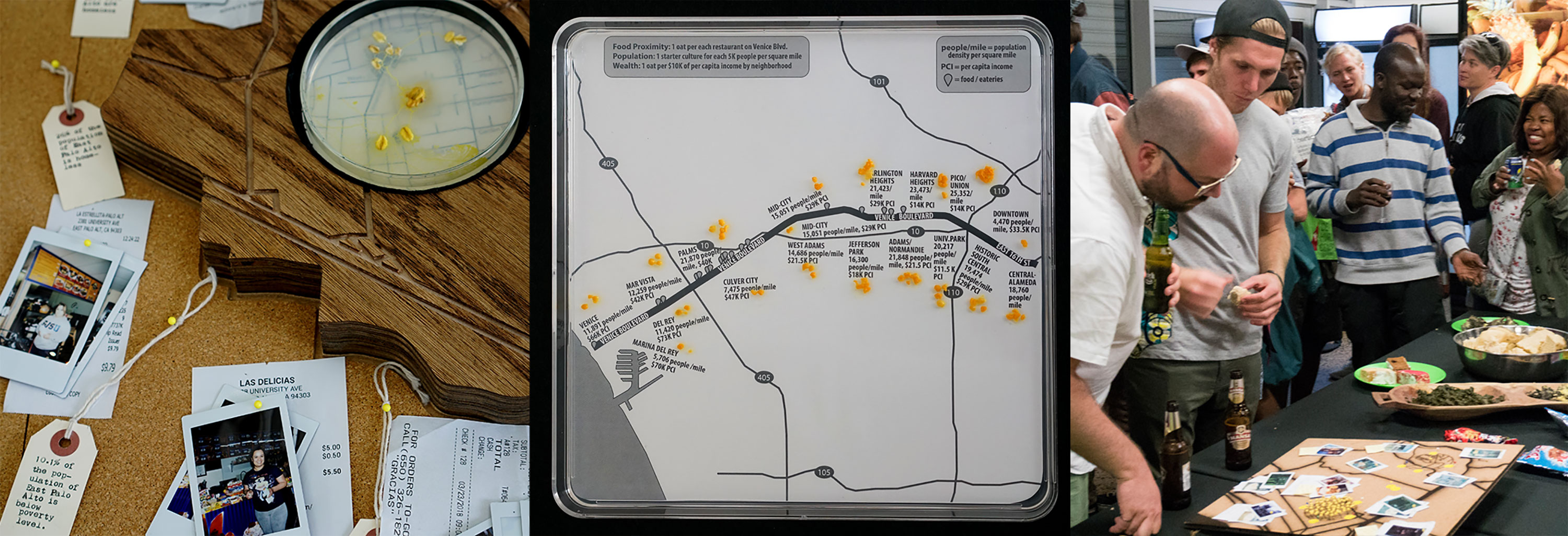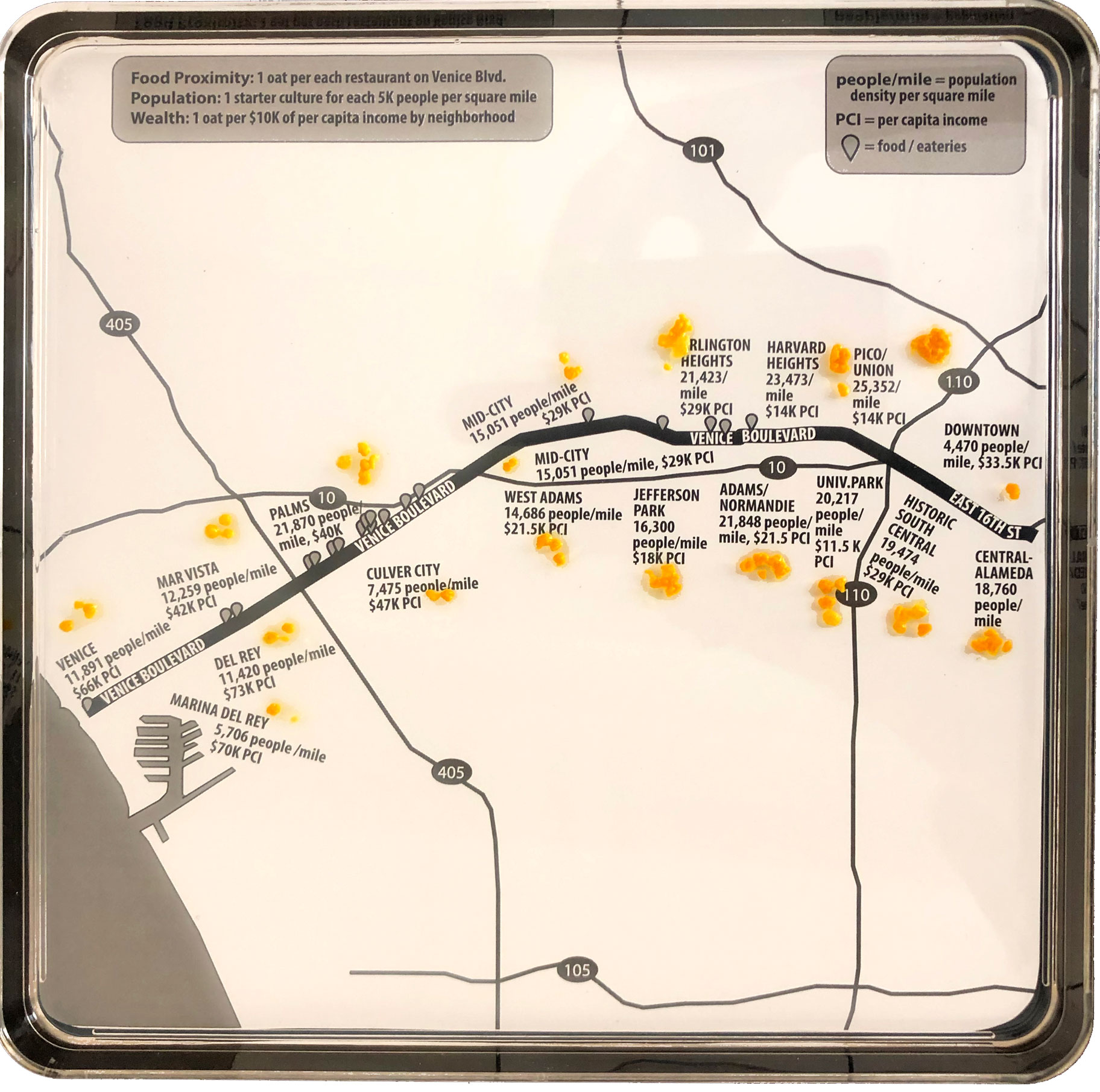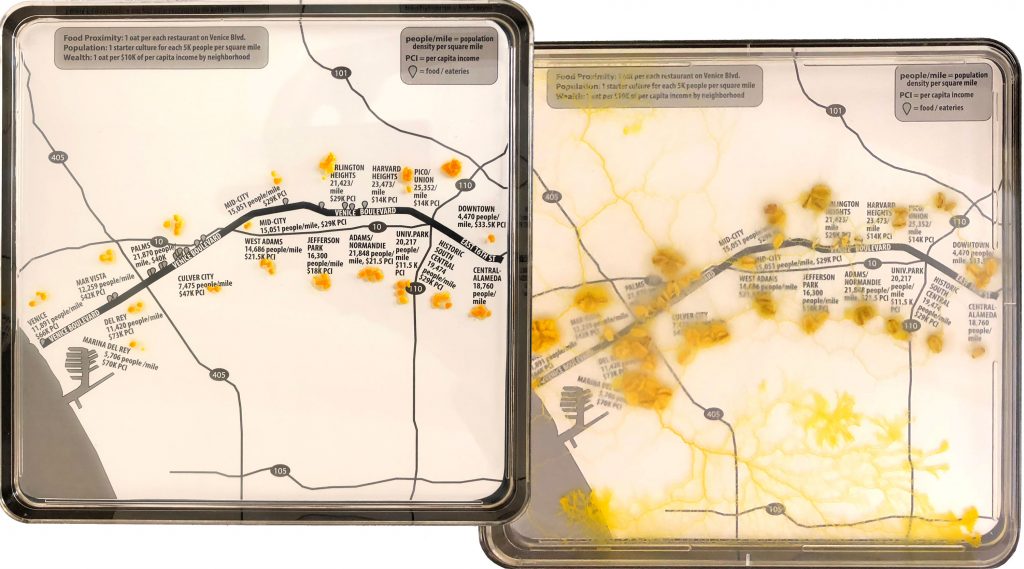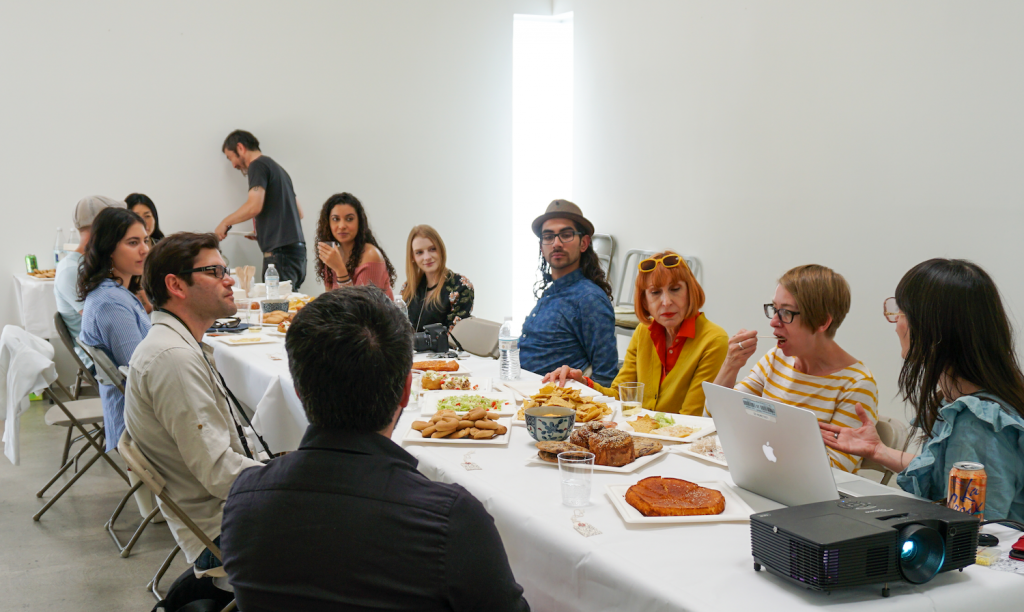[ECO]nomic Revolution
[ECO]Nomic Revolution is a series of experiments and performative installations in which Cesar & Lois makes microbiological mappings across different neighborhoods in order to reenvision the wealth distribution of neighborhoods through the lens of microbiology. The conceptual basis for this project is the organization of the microorganism called Physarum polycephalum, which has a biological system that distributes resources across nodes of a network in what seems an equitable and often the most efficient way.
For each edition of [ECO]nomic revolution, Cesar & Lois inserts demographic data into bio-data visualization (data visualization through living organisms), which manifests in art installations as happenings with living graphs, performances, and film narratives. Each edition involves performative artistic research into local relationships with food and the social structures that these organize within the urban space.

The project was realized in places with stark inequality, such as in the neighborhoods of Palo Alto and East Palo Alto in California, in Glenwood and Mayville in Durban, South Africa, and along Venice Blvd., moving from West to East Los Angeles. Walking through all these areas, one can see great wealth disparity and contrasting ethnic populations in neighboring communities.
In recording interactions in local communities, the artists purchase food in local markets or restaurants, share food with others they meet, and also buy food in different parts of the city to distribute and share during the project’s public happening.
The disparity in the distribution of resources (food, wealth, well-being…) between the compared communities is represented in different ways, ranging from the assembly of the meal table, to the set of diagrams for viewing demographic data and affective information collected in the process of intervention by artists in local communities.
The goal in layering such seemingly opposite studies—one centered around a city’s wealth distribution and the other on microbiological growth—has been to drive a closer association between the planning and allocation of a city’s resources and microbiological growth systems. The layering of each has propelled participants’ and community members’ awareness of and critique of current systems.
Cesar & Lois looks to Physarum polycephalum as a model for thinking across networks and with global ecosystems. When layering the networked logic of this microorganism over different cities, we find that the disparity of wealth distribution among people can be mapped and visually assessed as a living, growing data visualization.
Silicon Valley Study
Cesar & Lois presented a living experiment of [ECO]nomic revolution at the LAST (Life Art Science Technology) Festival at Stanford at the SLAC National Accelerator Laboratory in April, 2018. The project visited adjacent cities where the extremes of economic circumstance are represented—Palo Alto and contrasting East Palo Alto.
As part of the project, Cesar & Lois created maps of the areas in two petri dishes, placing the microorganism’s food over places where the eateries are in the city.
The artists traveled in the urban space according to the path that Physarum polycephalum took. Similar to the way that the microorganism distributes resources, the artists shared food with a network of individuals that they encountered in both cities.
The physical installation includes maps of areas of the city that contrast one another in wealth and demographics; each of these maps is a substrate for microbiological colonies. The maps are embedded in the petri dishes holding living cultures and displayed alongside notes and photographs that document the interactions between the artists and those they shared food with.

Los Angeles Experiment
In the Los Angeles-based experiment, Physarum polycephalum grows along Venice Blvd., moving from West Los Angeles—where the population is not as dense and per capita income is high—to East Los Angeles, with a consistent high-density populations and low incomes.

In the map including contrasting neighborhoods spanning Venice Blvd. in Los Angeles, each neighborhood’s per capita income is represented by oats (1 oat is equivalent to $10K per capita income); human population is represented by the concentration of culture, with more yellow indicating more densely populated neighborhoods (1 starter culture for each 5K people per square mile). The networking microorganism, growing over the map according to the city’s demographics, with oats representing income, at first mimics how human cities operate.

With an abundance of oats, the culture on the West side grows to capacity and then overgrows the area, while the more concentrated culture on the East side, starved of resources (oats), blanches—showing signs of failing. This growth model resembles the gentrification that happens across human cities, as wealthy populations outgrow the area and seek to inhabit adjacent resources and space.
Ironically, the microorganism known for equitable distribution perfectly models human inequity—until, that is, Physarum polycephalum connects up with the other branches that represent the failing concentration of culture. Once the organism connects and forms a network, the system begins to modulate its growth and distribute nutrients in order to sustain and support the other nodes. The system’s logic overrules the desire to expand.

The experiment in Los Angeles was hosted by JAUS and included a discussion with LA participants spanning the city. Food for the event was sourced from eateries along Venice Blvd. following the growth route of Physarum polycephalum. Discussants ate food from the disparate cultural areas along the route while considering how a city grows, the root causes of gentrification and why those who move do so and what happens to under-resourced and often displaced cultures.

Durban Happening
As part of Urban Futures at ISEA 2018 in Durban, Cesar & Lois held a happening in which they shared food and conversations collected in neighborhoods with contrasting economic conditions.

The artists sourced food in the contrasting neighborhoods of Glenwood and Mayville, with distinct populations and sharp wealth disparity between them.
Embedded research included eating and cooking with hosts, and, with the aid of a guide and translator, interviews on personal and family food histories and cultural orientations towards cooking and sharing meals in communities of subsistence living.
Notably, the exhibition of the microbiological mappings and the happening in Durban were held at the Denis Hurley Center, a site where those in need are fed daily.
The shared food reflects the localities’ economic and cultural distinctions. Simultaneous to the actions, Cesar & Lois grew microbiological cultures according to the different neighborhoods’ demographics. The sharing of food mirrors that of the networking of Physarum polycephalum, a single-celled microbiological organism known for the equitable distribution of resources among individuals.
In [ECO]nomic revolution, by growing networking microbiological systems over human systems, the illogic of one becomes apparent through the logic of the other. In this case, Physarum polycephalum highlights the illogical distribution of resources and population across human communities—a distribution which lends to greater inequities across cities. The project underlies how microbiological processing of information, apparent in the decision-making that distributes resources across the network, can serve as a model for us to rethink human systems.